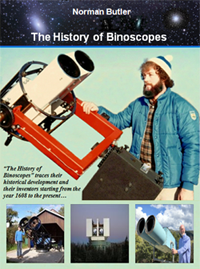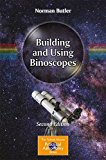
.
The new book " Building Binoscopes " is a simple easy to understand guide and instructions with many interesting and unique designs and illustrations for building a simple 10-inch f/5 open truss Newtonian binocular telescope Alt-azimuth mounted on a rotating pipe mount using simple hand tools and a variety of off-the-shelf parts, plywood and pipe fittings found at your local hardware store.
![]()
(Note that image is not to scale - For illustration purposes only)
One of the exciting new unique builds that's included in the new book is a 10-inch f/5 Newtonian "Bowling Ball" binocular telescope on a pipe mount. No one has built one before...but I'll show you how in this great new book. If you want to learn how to build a simple 10-inch binocular telescope...then this book is for you.
Keep Looking Up and Enjoy!
Norman Butler
Available on Amazon here:Building Binoscopes
Check out Norman's other books on binoscopes

The reader will have some reading fun once they open the cover of this new book. With each page, they will find out some new and possibly some old historical information about the invention of the binoscope . The new book covers the history of binoscopes from 1608 to the present and contains images of the inventors, their telescopes/binoculars and binocular telescopes (binoscopes), and some interesting and sometimes mysterious information and facts about the actual history surrounding the invention of the binoscope itself. The first three chapters in the new book talks about some of the very first telescopes/binoculars and binocular telescopes that were invented over the past 400 years... up to and including the present era of the Large Binocular Telescope (LBT) with it's dual 8.4M mirrors that's currently in operation on Mt. Graham in Arizona.
Building and Using Binoscopes 2nd Edition
Covering both homemade and commercial products, this book provides the reader with simple and straightforward information about the modeling, building, and use of binoscopes. Binoscopes can be thought of as binoculars enlarged to the size of telescopes - essentially, a combination of the two.
Constructing a binoscope is easier than most people think, but it still demands attention to detail and proper background knowledge. The author goes on to provide additional information about the products currently on the market, should the reader choose to purchase one instead of building it. Lastly, the book also compares binoscopes with telescopes in great detail, outlining the differences the reader can expect to see in the night sky from using both. The celestial views obtained with a binoscope, compared to a single telescope of the same aperture, are a very different experience.
The new edition emphasizes the obvious advantages of viewing celestial objects through a binoscope. There are also many new photos and additional information on the latest equipment and some very special and rare equipment a collector might be interested in. Newly added cartoons and additional images of beautiful deep sky objects in each of the chapters makes reading the book a more enjoyable experience. Finally, there is a new comet discovery form and guide to follow for such discoveries, and a complete list of Messier objects for those interested in searching for these.





